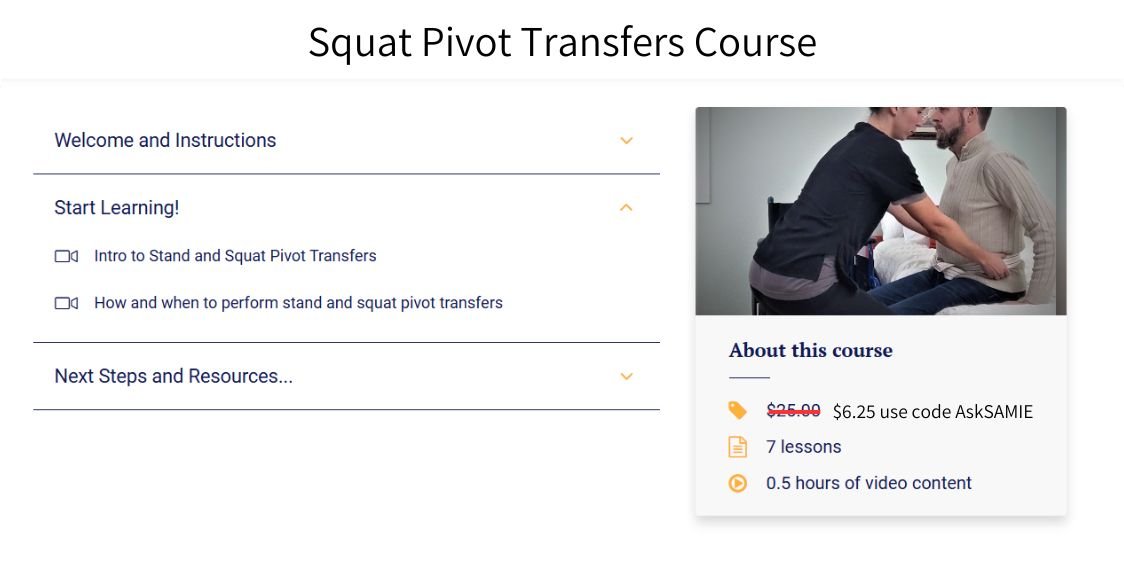Video Training: What, When, and How of Stand and Squat Pivot transfers
Video Training: What, When, and How of Stand and Squat Pivot transfers
Learn the 2 most common types of transfers, when and how to do them, and what to do to protect your back while keeping the person you’re caring for safe.
Higher Standards Caregiver Training has a catalog of over 30 specific and detailed training courses for family caregivers. With the ASKSAMIE coupon code you can get access to the entire catalog for 60 days for $19.99!
See the Advanced Family Caregiver Training University courses here!
Why we know this works
Why we know this works
You need credible, succinct and worthwhile education because this is all new! You are providing care to an important person in your life and you want to do it well. So connect with this course, specific to your learning needs and get confident with your new skills!
Specifications
Specifications
Duration: 30 mins.
Frequently Asked Questions
Frequently Asked Questions
Q: How does the Video Training: What, When, and How of Stand and Squat Pivot transfers work? This comprehensive video training course teaches family caregivers the two most common types of transfers - stand and squat pivot transfers. The course provides step-by-step instruction on proper techniques, timing, and safety measures to protect both the caregiver's back and ensure the safety of the person being cared for.
Q: What discount is available for the Video Training: What, When, and How of Stand and Squat Pivot transfers? You can save 75% on this training course by using coupon code ASKSAMIE at checkout. The course is normally $25, but with the discount code, you get it for just $6.25.
Q: Who should take the Video Training: What, When, and How of Stand and Squat Pivot transfers course? This training is designed for family caregivers who need to learn safe transfer techniques for mobility-impaired individuals. It's perfect for those caring for elderly parents, disabled family members, or anyone requiring assistance with movement and transfers.
Q: What will I learn in the Video Training: What, When, and How of Stand and Squat Pivot transfers? You'll learn the proper techniques for stand and squat pivot transfers, when to use each method, how to protect your back during transfers, and essential safety measures to keep both you and your care recipient safe during the transfer process.
Q: Is there a bundle option available with the Video Training: What, When, and How of Stand and Squat Pivot transfers? Yes! Higher Standards Caregiver Training offers access to their entire catalog of over 30 specific caregiver training courses. Using the ASKSAMIE coupon code, you can get 60-day access to the complete Advanced Family Caregiver Training University for just $19.99.
Q: How much does the Video Training: What, When, and How of Stand and Squat Pivot transfers cost? The regular price is $25, but with the exclusive ASKSAMIE coupon code, you can purchase the complete training for only $6.25 - that's a 75% savings.
Q: What makes the Video Training: What, When, and How of Stand and Squat Pivot transfers different from other caregiver resources? This training focuses specifically on the most common transfer techniques used in caregiving, providing detailed instruction on back safety and proper body mechanics. It's created by Higher Standards Caregiver Training, specialists in family caregiver education with over 30 specialized courses available.
Q: Can I access other caregiver training courses after purchasing the Video Training: What, When, and How of Stand and Squat Pivot transfers? While this is a standalone course, you can upgrade to access the full catalog of Advanced Family Caregiver Training University courses, which includes over 30 specialized training modules covering various aspects of caregiving, medical equipment use, and complex care situations.
Share


Solve the whole puzzle! Get more education, resources & services
-

Caregiver Training Courses
Go to website for the full training library We've partnered with Higher...
Dive Deeper: A knowledge base of solutions for real caregiving questions
View all-

💪 Gift Giving Guide for Hip & Knee Replacement ...
Discover OT-approved gifts that support healing and confidence after hip or knee replacement surgery. From bedside rails and bed trays to rollators, sock aids, and reachers, these tools make recovery...
💪 Gift Giving Guide for Hip & Knee Replacement ...
Discover OT-approved gifts that support healing and confidence after hip or knee replacement surgery. From bedside rails and bed trays to rollators, sock aids, and reachers, these tools make recovery...
-

👵 Gift Giving Guide for Grandparents - Top 5 Dr...
Discover the top 5 mobility aid gifts that help grandparents stay confident, safe, and independent. From rollator-wheelchair combos to walking sticks and reacher tools, these OT-approved picks make everyday movement...
👵 Gift Giving Guide for Grandparents - Top 5 Dr...
Discover the top 5 mobility aid gifts that help grandparents stay confident, safe, and independent. From rollator-wheelchair combos to walking sticks and reacher tools, these OT-approved picks make everyday movement...
-

💚 Gift Giving Guide for Loved Ones with Parkins...
Find meaningful, OT-approved gifts for loved ones with Parkinson’s. From easy-on clothing and tremor-control tools to mobility cueing devices and safe sleep aids, these expert-selected products restore confidence, reduce frustration,...
💚 Gift Giving Guide for Loved Ones with Parkins...
Find meaningful, OT-approved gifts for loved ones with Parkinson’s. From easy-on clothing and tremor-control tools to mobility cueing devices and safe sleep aids, these expert-selected products restore confidence, reduce frustration,...








